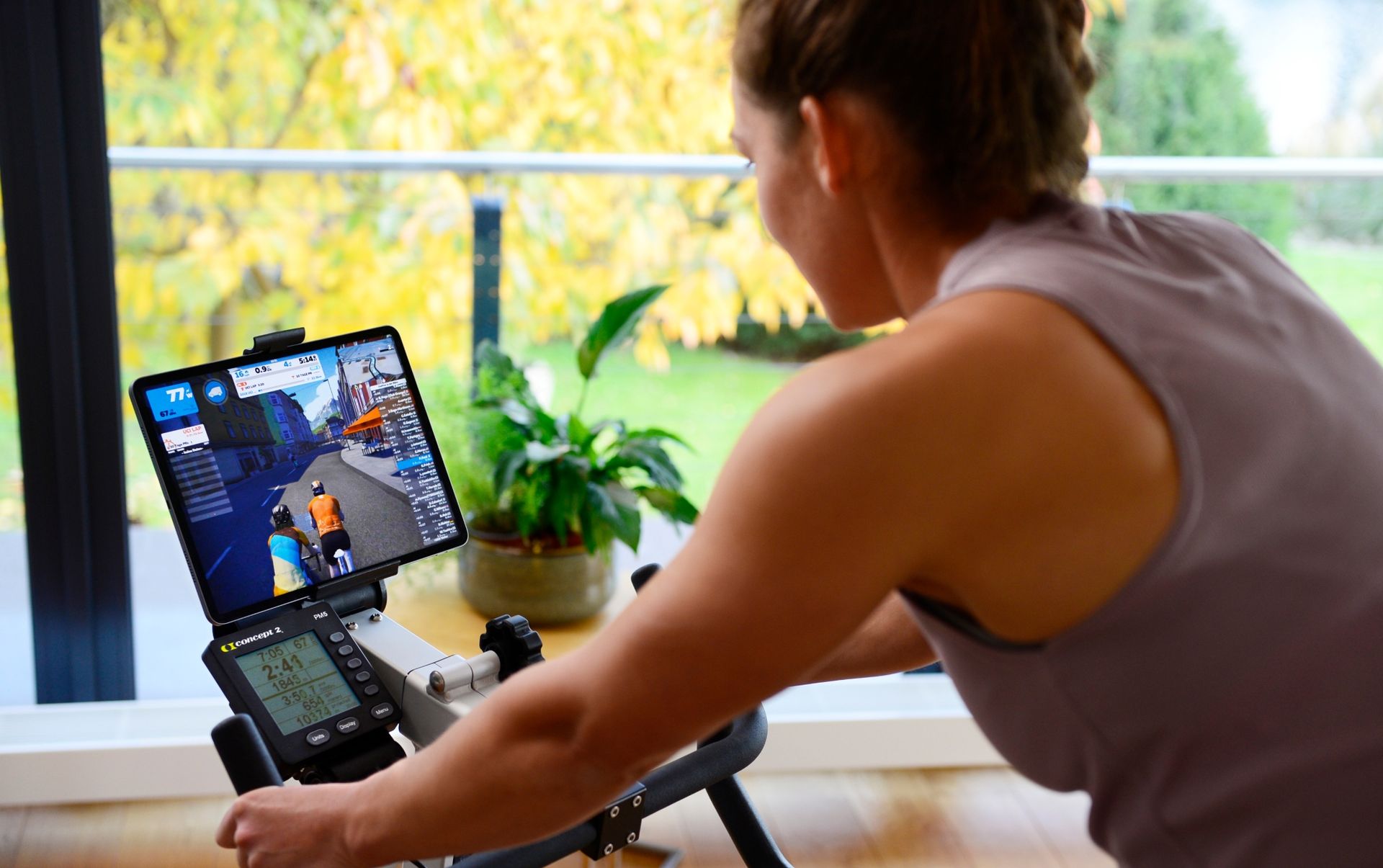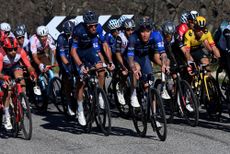Concept 2 BikeErg review
A great bridge across the gap between exercise, smart bikes and your wallet
- (opens in new tab)
- (opens in new tab)
- (opens in new tab)
- Sign up to our newsletter Newsletter

The Concept2 BikeErg is a decent compromise for any household made up of members looking to get the most out of their training by tracking reliable and repeatable data, without spending the mega bucks required for 'smart bikes' manufactured by cycling specific brands. The ability to closely mimic your road bike position, fit standard road components and measure performance improvement means this option outperforms regular exercise bikes. However, the method of power reading means you won't hit the same numbers as you would on a dedicated power meter, and we found the effect of a one-sided fan a little disconcerting.
-
+
Repeatable precision for measuring metrics
-
+
Connects to third party Apps via Bluetooth
-
+
Customisable for standard bike parts
-
+
Very smooth pedalling
-
+
Lightweight and moveable
-
+
Large data screen
-
+
Minimal maintenance requirements
-
+
Known for durability
-
+
Value for money
-
-
Damper adjustment on flywheel
-
-
Power taken at flywheel will read below crank/pedal meter
-
-
One sided fanning when riding
Why you can trust Cycling Weekly Our expert reviewers spend hours testing and comparing products and services so you can choose the best for you. Find out more about how we test.

If you've ever straddled a rowing machine in a gym, the chances are you have already become aquatinted with the brand Concept2. It's the very same company that hosts the indoor rowing championships, which the likes of James Cracknell and Sir Bradley Wiggins have competed in. In fact, any indoor rowing event, race or record will always be completed on a Concept2 rower because it's the gold standard when it comes to repeatable and comparable data on every machine.
It's this ability to replicate data with such precision that makes the Concept2 BikeErg very appealing as one of the best exercise bikes (opens in new tab).
Construction of the Concept2 BikeErg

The PM5 screen mid session showing time, interval number, average Watts and RPM.
The consistency that the brand is most celebrated for is down to its performance monitor, the PM5. It's this clever bit of software that provides repeatable and comparable data across all of Concept2's products.
On the rower (and Concept2 SkiErg) it measures acceleration and deceleration of the flywheel to calculate power, distance, and speed. On the bike however, with constant pedalling, you don't have a spinning flywheel to measure, meaning it requires slightly more complex inner workings in order to get the same dataset.
It's what Alex Dunne, Concept2 Managing Director UK, says put the brand off developing a bike for so long.
"There was user demand for a bike for a while," he told me "but we had to stay true to our goals of being affordable, reliable and repeatable so it took a while to make sure we had it right.
"We kept the air resistance, but this time the PM5 takes readings from pressure, temperature, angle and drag data in order to get power information. The PM5 monitor does this calculation instantly. In terms of the bike, the rider periodically recalibrates, which takes into account all conditions that would affect the flywheel, so you can be assured and confident."
Air resistance on a bike is probably an unusual concept (no pun intended) for most bike riders. In terms of 'riding' it makes very little difference, the pedals still go round, but this time you do away with the need for a heavy weighted flywheel, and either mechanical or electromagnetic resistance, and corresponding mains power requirement for the latter.
Resistance is adjusted on the bike by means of a manual damper, positioned on the flywheel, which opens and closes the fan, effectively acting as a gear change.
Doing away with the need for a heavy flywheel, and using an aluminium frame enables the Concept2 BikeErg to be exceptionally lightweight, at around just 68lbs/ 31kg, a good 11kg lighter than the Wahoo Kickr bike.
Arrival and set up
This lightweight nature and power free design means that the journey from unboxing to being up and running is remarkably swift, with just the legs, handlebars, monitor and crank arm to attach; all tools are included in the box.
There's plenty of adjustability in terms of position: bar height, reach, saddle height and set back can all be fine-tuned using tool-free ratchet systems.
In terms of rider requirements, this adjustability allows for an inside leg measurement of between 28inchs/ 71.3cm to 37inches/ 94cm as standard. If this rules you out, fear not as a 'Tall' seat post, which increases the inside leg height to 41inches/ 104cm, or a 'Short' seat post, which decreases it to 26inches/ 66cm is also available to purchase.
Handlebar wise, the reach ranges between 22.25inches/ 56.5cm up to 30.25inches/ 77cm, and has 10inches/ 25cm of height at the front end, add to this saddle fore/aft of approximately 1.5inches/ 38.1mm and 16degrees of seat angle adjustment, there won't be many riders left wanting position wise.
What you will probably still want is the ability to personalise your ride, so you'll be pleased to hear that you can swap out the handlebars (down to a 1inch/ 25.4mm clamp), and saddle. You can also swap out the pedals, which have a Q Factor of 155mm and a regular thread of 9/16in/ 20tpi. Q Factor influences how are your feet are apart as you pedal, at 155mm this is within range of standard bikes so shouldn't feel alien. However, you are stuck with the 170mm cranks. Some shorter riders favour 165mm cranks, and taller riders can prefer 175mm cranks, but this is unlikely to bother many recreational riders.
Once assembled, the Concept2 BikeErg is good to go using just the PM5 performance monitor displaying and recording data. From this alone you can see and track distance, speed, pace, calories and watts for each workout, and also choose between display options.
One simple step further is to google 'Concept2 BikeErg WOD (workout of the day)' and you are taken to the website page that offers three workouts to choose from, short, medium or long depending on your goals. You can then follow the button sequences on the screen to program the PM5 so all you have to do is the hard work of turning the pedals for the required time, duration or distance.
Alternatively, you can choose to use the PM5 wirelessly using ANT+ and/ or Bluetooth to connect to Concept2's own app, your own heart rate or power meter, and best of all, it's compatible with most indoor bike platforms, such as Zwift or Rouvy, Wahoo STSTM, to name but a few.
The ride
Firstly: it's insane how smooth the Polygroove belt and air resistance are in favour of a chain.
For me personally, where rides were an hour max at a time, I loved the get on and ride simplicity option of the Concept2 BikeErg. Even after a couple of months use, I wasn't moved to swap out the bars or saddle for my own. Both were really comfortable and allowed me to get a great position.
Not having any real specific training needs at the moment, I can often just amble on a bike without purpose. Being able to log on and pre-programme the unit according to the Concept2 WOD webpage was a perfect way for me to unwind and get a decent sweaty session under my belt utilising any widow of opportunity.
If you're a numbers junkie like me, this clear, repeatable and accurate measuring system of the PM5 will have a lot of appeal. It's an unemotional uncomplicated way of measuring progress that I find a great stress reliver. When there's no external variables to take into consideration, the numbers either point up or down, allowing you to truly measure performance over time.

The Concept2 BikeErg is compatible with third party virtual riding apps
On the flipside, my partner struggles to find motivation to just 'do a session', and needs more mental stimulation. The wireless connection to hop on a Zwift ride has been the smoothest and easiest set up of all the pedals/ turbos/bikes I've used thus far, and highlights the Concept2 BikeErg's superior software functionality.
It's worth investing in the screen mount if you are going to be opting for more online riding, as this securely holds a tablet screen.
Talking of secure, it's impressive how stable the flyweight bike is. The two mini roller wheels at the front of the bike legs mean it's effortless to move around, making storing the bike out the way really easy, yet even during full gas sprint efforts the bike is solidly planted.
It's also virtually noise free, with a constant 'shuushhhh'ing over a drone, or vibration baseline that turbos or exercise bikes are better known for, although it is still an air fan, so if you are pressing on, the volume will increase.

Adjusting the damper is the equivalent of changing gear on a bike.
The other point to note on an air resistance bike is airflow. While I did appreciate the cooling effect of a gentle breeze, I found it slightly jarring to have it constantly and only on my left hand side.
But the real 'ah' moment here is when you realise that in order to change gear you need to reach down to that same flywheel and physically move the damper.
Ideally, I would like to have 'gear shift' on the bars and a centrally located flywheel to balance out the wind chill.
Data accuracy

While you aren't getting the remote resistance control that other smart bikes can provide, you are theoretically getting absolute true data ride after ride. This means improvements are easily visible, as are areas you need to work on.
On a less positive note, taking power reading at the flywheel means that some watts are lost, when compared with more direct measurements - for instance at the crank or pedal. Attaching a pair of power meter pedals, you will see a +15 - 20% difference which is a big factor to take into consideration if you are intending to race online.
We found a far smaller discrepancy when comparing readings from the Peloton exercise bike against a pair of Garmin power pedals, which is disappointing as the Peloton simply uses an algorithm based upon cadence and resistance level.
However, thanks to this strain gauge positioning, a self tensioning belt and other metrics such as air pressure in the PM5 calculation, you are consistently getting comparable data.
The honest truth is that studies show drift among almost all popular power meters. The important take-home is that is the Concept2 BikeErg is repeatable to its own metrics, so if you want an accurate measurement of your own performance then the PM5 monitor will show you that. Our experience was just that it didn't give us bragging rights among friends, and we'd probably pair it with power meter pedals if we were to race online.
Value
The Concept2 BikeErg plugs the gap between inexpensive exercise bikes, and expensive smart bikes such as the Wahoo Kickr Bike.
The biggest trade-off is with the mechanical flywheel damper design. Its simplicity enables the accuracy, consistent repeatability and durability for around $2.5k/ £2k less than a smart bike. But, if you want to race online, it might be a compromise too far.
If not, the Concept2 BikeErg comes in at a third of the price of a smart bike, and it's more accurate and 'bike' like than an exercise bike will ever be, making this middle ground really appealing.

Thank you for reading 10 articles this month* Join now for unlimited access
Enjoy your first month for just £1 / $1 / €1
*Read 5 free articles per month without a subscription

Join now for unlimited access
Try first month for just £1 / $1 / €1
Hannah is Cycling Weekly’s longest-serving tech writer, having started with the magazine back in 2011. She has covered all things technical for both print and digital over multiple seasons representing CW at spring Classics, and Grand Tours and all races in between.
Hannah was a successful road and track racer herself, competing in UCI races all over Europe as well as in China, Pakistan and New Zealand.
For fun, she's ridden LEJOG unaided, a lap of Majorca in a day, won a 24-hour mountain bike race and tackled famous mountain passes in the French Alps, Pyrenees, Dolomites and Himalayas.
She lives just outside the Peak District National Park near Manchester UK with her partner, daughter and a small but beautifully formed bike collection.
-
 Government budget cuts make net zero target ‘impossible’ say cycling groups
Government budget cuts make net zero target ‘impossible’ say cycling groupsCuts of hundreds of millions of pounds were buried alongside delays to HS2 rail project
By Vern Pitt • Published
-
 Primož Roglič snatches overall lead at Tirreno Adriatico with stage five victory
Primož Roglič snatches overall lead at Tirreno Adriatico with stage five victorySlovenian took his second stage in two days, outsprinting Giulio Ciccone and Tao Geoghegan Hart on the Sassotetto climb
By Tom Thewlis • Published
-
 UCI ‘examining’ Strade Bianche podium rider’s use of blood monitor
UCI ‘examining’ Strade Bianche podium rider’s use of blood monitorKristen Faulkner spotted using Supersapiens-style disc on her arm during the race
By Vern Pitt • Published


